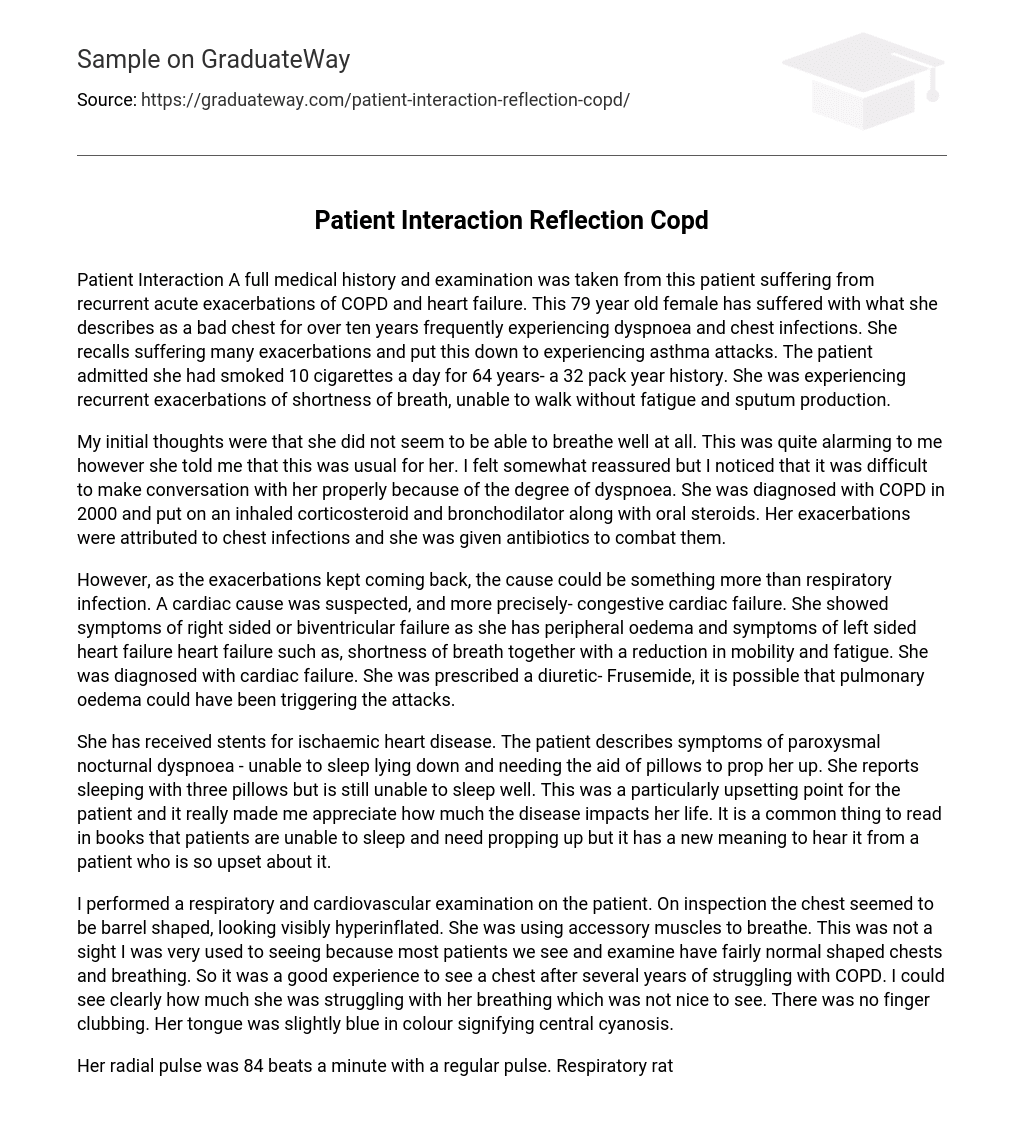A 79-year-old woman has been experiencing recurrent acute exacerbations of COPD and heart failure. She underwent a comprehensive medical history and examination during the patient interaction. The patient has been struggling with a severe chest condition for over ten years, which often leads to breathing difficulties and chest infections. She believes these exacerbations are caused by asthma attacks. Additionally, she revealed that she has been smoking 10 cigarettes per day for 64 years, resulting in a cumulative exposure of 32 pack years. Currently, she is having frequent exacerbations characterized by shortness of breath, fatigue while walking, and increased sputum production.
At first, I noticed that she was experiencing difficulty breathing, which made me concerned. However, she reassured me that it was something she often experienced. While this calmed my worries to some extent, her severe breathing difficulties made it hard for us to communicate properly. In 2000, she was diagnosed with COPD and given inhalers containing corticosteroids, bronchodilators, and oral steroids as treatment. Whenever she had chest infections, they would worsen her symptoms and require antibiotics.
Despite the suspicion of a respiratory infection, there was concern about a different underlying problem due to the recurring exacerbations. The patient exhibited symptoms indicating right-sided or biventricular failure, such as peripheral edema. Additionally, she displayed symptoms associated with left-sided heart failure including shortness of breath, decreased mobility, and fatigue. Ultimately, a diagnosis of cardiac failure was given and the diuretic Frusemide was prescribed. It is possible that the attacks were triggered by pulmonary edema.
The patient has received stents for ischaemic heart disease. She is experiencing symptoms of paroxysmal nocturnal dyspnoea, such as inability to sleep while lying down and requiring pillows for support. Even with three pillows, she still struggles to achieve proper sleep. This aspect of her condition greatly distresses the patient, providing me with a true understanding of how the disease affects her life. While it is common to read about patients needing to prop themselves up to sleep in literature, hearing it directly from a deeply upset patient offers a fresh perspective.
During the examination, the patient’s chest appeared barrel shaped and visibly hyperinflated. The use of accessory muscles to breathe was observed, which was uncommon for me as most patients have normal chest shapes and breathing patterns. Witnessing a chest affected by COPD after years of encountering such cases provided valuable experience. It was distressing to witness the extent of the patient’s breathing difficulties. No finger clubbing was observed, but the tongue displayed a slight blue color indicating central cyanosis.
Her radial pulse was 84 beats per minute and regular. Her respiratory rate was 15 breaths per minute. On auscultation, she had normal heart sounds and no murmurs. There was an expiratory wheeze in both lungs. I could hear crepes bilaterally, with more crackling on inspiration and wheezing on expiration, which may indicate pulmonary edema. On palpation, percussion was more resonant on the left, as well as vocal and tactile fremitus. There was also greater chest expansion on the left than on the right. She exhibited bilateral peripheral edema at the ankles.
This patient is displaying symptoms of right-sided heart failure, including peripheral oedema. However, there are no signs of ascites or hepatomegaly. According to her medical records, the first documented chest infection occurred at age 70 and was identified as an acute respiratory infection. Since then, she has experienced recurring chest exacerbations. Recent lung function tests revealed an FEV1 of 0.53L/s, which is only 27% of the expected value. Additionally, her FEV1/FVC ratio was 66%, categorizing her as stage IV COPD according to the GOLD classification. This stage puts her at risk for cardiac complications such as cor pulmonale.
According to the MRC dyspnoea scale, this patient has a severe level of dyspnoea. She consistently experiences shortness of breath and is unable to perform daily tasks or walk long distances. If her condition were classified according to the New York Heart Association classification for congestive heart failure, she would be categorized as stage III, indicating a moderate level of impairment. This encounter provided me with a firsthand understanding of how a chronic illness affects a patient physically and impacts their daily life. It was highly beneficial for me overall. Additionally, by examining her, I had the opportunity to observe symptoms that are not typically seen in most patients, which made it a valuable learning experience.





